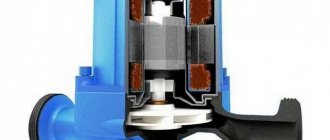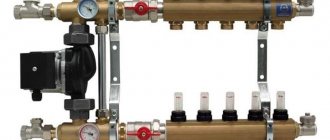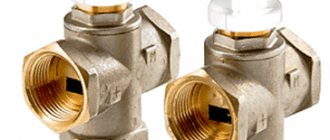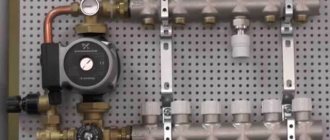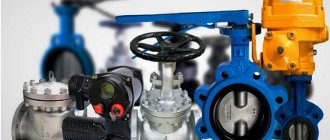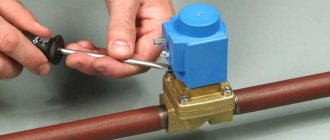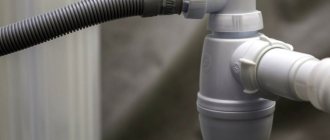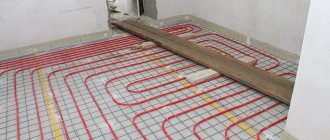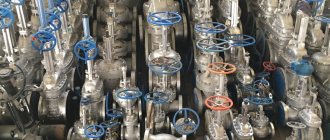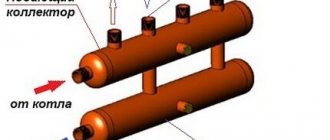Drive types and selection criteria
Automatic valve with electric drive
According to the type of drive, the models are:
- Mechanical
, the separator is installed manually. To monitor temperature indicators, a thermometer is installed on each incoming pipe. - Automatic
, the movement of the membrane depends on the temperature and is carried out independently.
The drive can be:
- Thermostatic
, in which the sensitive element expands under the influence of temperature and begins to put pressure on the valve stem, mixing cold flows with hot ones. - Electrical
, in which signals are supplied from the control unit. - Cap type
, the tap is controlled by pressing the head on the drive rod; the drive is applicable when installing a floor heating system.
When choosing a three-way valve, the main thing is the type of actuator. Manual drive control is cheaper, but has few functions. Electric models are expensive and break down quickly, but their versatility does not leave most consumers indifferent. Bronze brass faucet material is durable but also expensive.
The best option is cast iron, copper.
When choosing, take into account:
- Media consumption.
- Strapping diagram.
- Operating parameters.
Flow and temperature must be indicated in the design documentation; if it is not available, the optimal water heating temperature is indicated in the passport, usually not higher than 50 degrees. Flow is taken into account when selecting a valve based on its capacity.
The type of drive must correspond to the wiring diagram.
A thermostatic valve has a simpler scheme, in which water circulates through the third pipe to the first, the boiler heats it, and only after that the coolant begins to warm up. Having heated up to the required temperature, out of three possible ones, the tap opens flows of cold water from the second pipe, replacement occurs, cold water leaves, hot water enters the tank with a heat accumulator.
The piping scheme is more complicated when an external controller is installed on the crane.
In this case, dual-drive and dual-circuit mixers will be required. The first circuit is installed next to the heat source and is thermostatic. The second drive is electric, controlled by the controller by sending sensor signals, the faucet maintains the temperature of the coolant.
An important criterion when choosing a device is the temperature range
, products, as a rule, in this case have a thermostatic drive in the piping of hot water boilers and underfloor heating systems. The range of taps depends on the purpose of the products, ranging from 20-43 grams, 35-60 grams and above. It is advised to stick to the second option when purchasing.
When installing the piping, it is worth asking how the tap is checked. If the product is new, it is not difficult to check it; the minimum temperature in the range is set in the third pipe, hot water is poured. After 15 - 20 minutes, the pipe should turn off the tap.
You can check the device in an already installed system by measuring the water temperature at the entrance to the boiler, that is, on the back side of the pipeline the value should be the same as on the thermostat.
Strapping diagram:
Design and principle of operation
To understand what the thermo-mixing three-way valve of the most common saddle type consists of and how it works, you should study the diagram below. Inside the brass body with three nozzles, 3 chambers are arranged using the casting method, the passages between which are blocked by poppet valves. They are fixed on one axis - a rod coming out of the body on the fourth side.
In a 3-way mixing tap, the outlet pipe (from where the mixed water comes) is always open, the remaining 2 fittings are alternately closed with a thermal head
The operating principle is as follows: when you press the rod, the passage for one flow will begin to open and gradually close for another, resulting in water of the required temperature in the mixing chamber of the valve. It leaves the brass body of the element through the third pipe. The pressure on the rod is adjusted using a thermal head with a remote temperature sensor installed in accordance with the diagram.
The whole process is worth explaining in more detail:
- Imagine that an insufficiently heated coolant comes from the hot water side. Then the mechanism passes it further, and the third pipe is closed. The remote sensor is filled with a heat-sensitive liquid and is connected through a capillary tube to a reservoir (bellows) inside the thermal head.
- When the sensor heats up, this liquid expands, its volume in the tube and bellows increases, as a result of which the latter begins to press on the three-way valve rod. The moment of pressing is determined by the adjustment on the scale of the thermostatic head, set to the required temperature.
- After this, cold water from the third pipe is mixed into the flow of heated water and the temperature of the water at the outlet of the thermal valve remains unchanged, although heating of the coolant at the inlet continues.
- If the incoming water continues to heat up above normal, then to maintain the set outlet temperature, the thermostatic valve can completely close the inlet and open the side flow. In this case, the rod lowers to its lowest position.
- As soon as the sensor detects cooling of the coolant, the head slightly releases the stem, the valve seat on the hot side opens and the addition of heated water begins.
The method of adjusting a three-way tap using a thermostatic head with a sensor is the most popular because it is quite accurate and simple, and does not require electricity.
If we are talking about a dividing valve, the principle of its operation is almost the same, only when you press the rod, one flow begins to divide into two. But in the switching element, the direction of movement is changed by the electric drive, which is described in detail in the video:
Adjustment mechanism
Thermostatic mixing valve
A thermostatic mixing valve is also used in radiator-type heating schemes, but convective air circulation (even with balanced ventilation and careful insulation) still leaves the lower layers as the coldest part of the room.
The source of thermal energy can be either a central heating plant or an autonomous boiler. In any case, boilers operate effectively in stable modes and will not provide smooth adjustment of coolant flow in each individual room.
For this purpose, special fittings with selected operating parameters and a specific type of design are included in the system. Installing a mixing valve for underfloor heating gives the following stabilizing result in normalizing the temperature in the house:
Mixing valves perform the task of combining a high-temperature heating circuit with a low-temperature underfloor heating distribution, since the recommended temperature in the pipes under the floor is 40°C, and for the water leaving the boiler 70 - 90°C.
Work principles
If the coolant is too hot, a cold stream is mixed into the water
The three-way valve for heated floors performs its function in the following order:
- the hot coolant from the boiler is directed to the distribution manifold, from which it diverges through the loops of the underfloor heating system;
- a thermo-mixing valve is installed along the path of movement, reacting to the heating temperature of the water;
- when the flow temperature exceeds the set value on the regulator, the latter opens a passage for mixing cooled water from the return pipeline;
- in the tee, two converging flows are mixed and the coolant of the desired temperature is released into the system;
- When balance is achieved, the change in the internal sections of the valve stops.
The valve body is made of brass and consists of 3 channels converging to the adjustment mechanism. The use of 3 different methods of mixing water flows distinguishes 3 types of three-way valve designs.
Three way thermostat
The thermostat mixes hot and cold flow
The set temperature is maintained by a three-way thermostatic valve, which automatically mixes the hot liquid flow from the heater and cooled water from the return pipeline. The need for quantitative changes in flows is determined by the thermostat settings.
This product can be used in underfloor heating systems (especially complex configurations), on radiator wiring and in the internal hot water supply circuit.
Automatic change in the temperature of the outgoing coolant protects a person from elevated temperatures in the event of a pipe rupture. If for some reason the flow of cold water stops, the valve will automatically close the flow of hot pressure from the boiler. The temperature-sensitive unit responds to the amount of heating and, accordingly, changes the cross-section of the inlet holes, achieving the required balance.
The layout of the thermostatic valve for a heated floor looks like this:
A pressure throttle is a device that provides fluid pressure regardless of the pressure difference at the inlet and outlet. Paired with a thermal head for a heated floor, it stabilizes the operation of all system circuits when incoming conditions change.
3-way thermostatic valve
The operation of this valve is not as complicated as a thermostat. Only the incoming hot media is regulated. For more information about the operation of three-way valves, watch this video:
To analyze changes in temperature indicators, the kit includes a thermal head for heated floors, which acts as an executive body based on a signal from an external sensor.
Mixing valve
Manual valve adjusted manually
The three-way mixing valve, which is not equipped with sensors and automation, is even simpler. The manual valve needs to be forced to set the position of the regulator to obtain the desired outlet temperature.
This crane is manufactured in 2 types:
- has a T-shaped passage (symmetrical design);
- internal L-shaped passage, (asymmetrical).
The differences are that with a symmetrical scheme, 2 jets meet from opposite arms of the valve and go into the side branch already in a mixed state.
Features of automatic devices
To ensure efficient operation of the thermomixing valve, the process of creating a mixed fluid flow must be continuously monitored. It is better if this is done automatically.
Automatically controlled devices are regulated by electrical or pneumatic components.
- Electric drives are relatively inexpensive and easy to connect. This largely explains their popularity and wide distribution. On the other hand, their dependence on power supply and the need for periodic maintenance make them not reliable enough.
- Pneumatic actuators are more expensive, and their connection procedure is more complicated. However, these shortcomings are compensated by a long service life and complete autonomy.
We recommend that you read: How to choose and install a water tap?
Types of 3-way valves
All thermostatic three-way valves for heating are divided into 3 types according to their design and operating principle:
- mixing;
- dividing;
- switching.
The purpose of each of the 3 varieties can be judged by its name. The first type of valve mixes two coolant flows with different temperatures, the second one separates, the third switches water between 2 lines. It is not difficult to recognize them externally; usually the principle of operation is depicted on the body in the form of a picture. Here's what a three-way mixing valve looks like:
The nameplate from Herz clearly shows the mixing of 2 flows, which means this is a mixing valve
A similar designation appears on the separating element. As for switching taps, there may not be an image on their body, but there are significant external differences in shape.
Separating (photo left) and switching (right) 3-way valve
By mixing or separating flows, the optimal temperature of the coolant supplied to the radiators of the heating system or underfloor heating circuits is achieved. Switching is used in gas double-circuit boilers, when heated water must be alternately directed to different heat exchangers.
Rules for installing a three-way valve in a heating system
It is not difficult to install a three-way valve with or without a servo drive with your own hands. This is just a shut-off valve, but it should be noted that it can have different methods of fastening. There are usually two of them: threaded or flanged. In the first position, the thread can be internal or external. In any case, the connection to the pipes is made using sealing materials such as fum tape or tow. As for the flange connection, to ensure its tightness it is necessary to make a gasket from heat-resistant rubber or paranite.
Correct connection of the valve to the pipes
There are two nuances that relate to proper installation:
- The device is usually installed on the return circuit before the circulation pump, because the outlet pipe is always open.
- The valve must be installed in the pipeline system exactly in the arrow of the coolant movement. The latter is indicated on the device body.
Types of connection between valve and pipes
Water circuit installation diagrams
If the installation of warm water floors is carried out using a well-established, traditional technology in a clear sequence, then the installation of a heating pipe can be carried out in various variations. The main goal pursued when installing heated floors is to uniformly heat the entire area of the heated room. Laying a pipeline just the way you want means deliberately creating problem areas throughout the entire structure. The coolant tends to quickly lose temperature as it flows, so the pipes must be laid starting from the walls, then moving towards the entrance to the room or to its center. For this purpose, specially developed optimal schemes for laying the water circuit, each of which has its own characteristics.
The mixing unit and manifold are the beginning of the entire heating system. Water circuits are connected in a clear sequence. The beginning of the pipeline is to the inlet pipe, the end of the pipe is connected to the check valve.
You can install a warm water floor with your own hands, the contour of which will be laid as follows:
- pipe installation according to the snake pattern"
- laying the pipeline according to the snail pattern;
- combined scheme.
When installing heating in corner rooms, a pipe laying scheme is used for enhanced heating.
In each individual case, we can talk about the advantages of one or another scheme. For example: a snail is the simplest circuit. The bend of the pipe here reaches 900, while in a snake the heating pipe will be bent by 1800.
Where heated rooms have a linear slope, it is better to install the pipe according to the “snake” pattern. The pipeline is laid in the direction from the mixing unit towards the slope. Air pockets in this version can be easily removed, which cannot be said about a pipe laid in a snail pattern. In sloping rooms, removing air pockets can be problematic.
For large premises where it is necessary to use several water circuits of the same length for heating, the “snake” pipeline laying scheme is very convenient. Thanks to this installation method, it is possible to achieve balanced operation of the entire heating system.
Heating pipes laid on a prepared base are connected to a manifold that distributes the supply of coolant to the system. The distribution cabinet together with the mixing unit is installed either in the heated room or next to it, which significantly reduces the number of pipes and the consumption of other materials. The bends of the water pipe at the point of connection to the collector are sewn into a special protective box.
In each individual case, a certain order of laying the water pipe should be followed. When working with a snail circuit, the pipe is first laid along the perimeter of the walls, after which a turn follows from the farthest wall. In the opposite direction, the pipe is laid in a spiral, reaching the center of the heated room. For the snake circuit, the water circuit is laid out as follows. The pipe is laid along the perimeter of the walls, after which uniform bends are made in the opposite direction.
The combined installation schemes of heating pipes for heated floors, used in some cases, involve the simultaneous use of both options. One half of the room can be heated by a water circuit laid in a snake pattern, while the other part of the room will be heated by a pipe mounted in a snail pattern.
Options for using a three-way valve for heated floors
In small rooms (bathroom, kitchen, toilet) it is not necessary to install a fully functional mixing unit. The costs for it may exceed the total cost of other elements of the heated floor. Here it is quite possible to get by with a regular three-way valve. Temperature control is provided by a thermostat. There are also options for manually adjusting coolant flows. Devices with a handle are used for this, but their accuracy, efficiency and ease of use leave much to be desired.
We recommend that you familiarize yourself with: Operating principle and scope of application of wedge valves
For larger systems, the inclusion of a mixing unit in the diagram is already considered mandatory.
The installation of heated floors in large rooms or multi-storey buildings involves the installation of several heating circuits of various lengths. Accordingly, several mixing units will have to be installed.
In such schemes, you can use the joint operation of several devices:
- Servo. A device capable of sending commands to open or close the damper based on signals coming from sensors. Allows the supply of coolant of various heating levels to certain zones of the heated room.
- Three-way valve.
- Controller.
The controller sets the limit values of the temperature range. After passing through the unit, the coolant can enter the desired room, or pass through a collector, which will distribute the flows along the circuits.
Temperature adjustment
The operating temperature of the underfloor heating fluid may vary depending on the quantity, length of circuits and general operating conditions of the system. The main value is the temperature in the circuits; its value is accepted as the most comfortable in the range of 35-45 degrees (up to 55 if the loops are long).
When supplied from the network, the temperature of the medium is too high, such values are unacceptable for pipelines and high-quality regulation is simply necessary. In some cases, it is necessary to install an intermediate heat exchanger, which heats a separate coolant in the underfloor heating system to acceptable values.
When the system is powered by its own boiler, it is possible to initially set the supply temperature, which simplifies the operation of the mixing unit and makes the system operating mode less aggressive.
Constant control of the coolant temperature is the prerogative of sensors working in conjunction with the system control unit (it is often mistakenly called a thermostat, which is not entirely true). A warm floor is a very inert system that reacts to any impact with a delay. Therefore, constant monitoring of small fluctuations with immediate temperature correction is necessary to avoid significant changes in operating conditions.
Adjustment can be carried out on a simple mechanical principle - like a thermal head - to a complex system of temperature sensors located directly next to the heated floor pipes and collecting information on a common control unit, which, using servo drives, regulates the operating parameters of the system and displays the data.
A simple solution
The main characteristic that describes the mixing unit for heated floors is throughput. To achieve noticeable control efficiency, the water passage and temperature drop between flow and return must be significant. This is the case in large houses. With a small heating area, the use of a complex, automated three-way unit does not show a noticeable effect.
In order to regulate the microclimate with short lengths of underfloor heating circuits, you can use a three-way mixing valve. This device works on the same principle as a temperature-dependent unit. But adjusting the amount of incoming hot water and return water is done manually. In an apartment, a unit that is not particularly complex and has a low cost is very effective.
The advantage of a simple three-way valve is its reliability. There are no bimetallic heat-sensitive parts or other components that can change their characteristics over time and require replacement. Three-way valves are replaced entirely if their control element, due to clogging or time of operation, has ceased to fulfill its main task.
What does a three-way valve with a thermostat do?
This valve narrows the flow of water, due to which its quantity decreases, and the outgoing heat is supplied in smaller quantities. The device is responsible for regulating the amount of water to control the temperature in the room or floor.
Device
In terms of external characteristics, a three-way valve for heating with a thermostat is very similar to an ordinary tee for dividing water, but in fact, all parts of this “tee” perform special functions.
- Thermal head with durable sensor. With the help of such a device, the temperature of the water entering the valves is adjusted and regulated.
- The upper poppet and lower poppet valves are necessary to start the mechanism, as they optimize the operation of the main valves, distilling water and thereby giving it the required temperature.
- One valve through which hot water enters the three-way valve.
- The second valve through which cold water enters the device.
- The third valve, from where, through the operation of the upper disc and lower disc, water is formed at the temperature that is set through the thermostat.
- Pressure relief chamber. This equipment controls the water pressure in the valves, increasing their performance and relieving them of pressure.
- Gland seal. The device guarantees the tightness of the entire structure. It is necessary due to the fact that the compartments and the heating circuit quickly fail due to any minor breakdown, since water “does not like” when it is handled carelessly, and when the opportunity arises, it tries to flow out of the pipes, flooding the surrounding space.
Principle of operation
There are two types of design:
- saddle;
- turning.
The principle of operation depends on what type of design is installed on the device.
- If it is a saddle, then the movement rests on the translational movement, where the rod constantly enters the saddle, then flies out of it.
The seat is either completely closed by the stem, or only slightly opens the mouth, releasing water. Thus, the saddle type of structure drives water and regulates the amount of hot or cold liquid coming out of two valves, while simultaneously mixing and transferring the resulting water in temperature and quantity to the “mixing” compartment.
- If it is rotary, then the regulator becomes not a rod, but a small ball or sector (part of a sphere). A device such as a conventional ball valve works: the ball rotates, allowing the passage of liquid either from a compartment with hot water or from a cold water tap, as with a saddle-type system, only instead of a rod there is a ball that operates without a seat on the overlap of two valves. Mixed water comes out of valve 3, set at temperature through a thermostat.
The temperature set through the device is maintained between two compartments with hot and cold water supply. When it changes, the gas located in this place begins to narrow or expand, depending on the change in the adjustment parameters.
This gas presses on the rod or ball, opening one of the valves, thereby flowing out the required amount of water and creating a new temperature corresponding to the set one.
Types of Valve Actuators
Valve Actuator Types:
- Direct acting valves. They function as follows: when the temperature changes, the expanding gas presses on the ball, sector or rod.
The thermal part of the three-way valve is located here, however, this equipment is not present in all devices. The sensor in such a device can be a probe located inside the pipeline.
- Indirect acting valves. They work in much the same way as direct-acting valves, differing only in smaller, but no less important, functioning.
Three way thermostatic mixing valves:
- Mixing. Such a device has 2 pipes, one of which is output. The first pipe is equipped with warm or hot water, and the second is connected to the “return” system, i.e. all the cooled water remaining after the previous heating is returned to it. When both pipes are opened, the water is mixed and, under the control of the thermostat, the desired outlet temperature is set. Then the water spreads throughout the entire circuit.
- A separating valve is a device that works inversely to a mixing valve, not combining water into one stream through the outlet, but, on the contrary, dividing a whole mixture of water of different temperatures into hot or cold. For this type there is one entrance and two exits. The design is used in bathrooms, if it is necessary to have hot water only from one tap and cold only from another tap.
Installation of a thermal mixer for heated floors
Correct installation of a three-way valve on a heated floor involves not only connecting the equipment to the pipeline, but also carefully checking it. Mistakes can lead to big troubles. Installation of the device is carried out when connecting the collector and before pouring the concrete screed for the heated floor. At this stage, the system is fully assembled and tested at a media temperature of no higher than 22-250C. The build quality testing period must last at least 24 hours. After making sure that the system is working correctly and there are no leaks, you can complete the installation.
To connect a three-way valve for heating with a thermostat for a heated floor, use ordinary wrenches. They are used to screw the internal/external thread of the device onto a fitting or union nut of the pipeline. The tightness of the connection will be ensured by plumbing flax, FUM tape or other materials. Special silicone gaskets are supplied with the faucet. When working, you need to make sure that they are laid in the socket, otherwise a tight connection cannot be achieved.
During installation, avoid:
- excessive impact on the threaded connection;
- distortions of pipes, especially at joints;
- loose or loose screwing.
Installing a faucet is a crucial moment, since its operation and the threaded connections obtained during installation will be exposed to moisture and high (differences) temperatures. Therefore, all work must be carried out carefully and accurately. The process of assembling the mixing unit is completed by adjusting the three-way valve for the heated floor using a head. If you don’t have confidence in your own abilities, it is better to leave the installation and purchase of the necessary equipment to assemble the system to professionals. Remember: a warm water floor can cause not only damage to the floor covering, but also the inability to create optimal comfortable living conditions in the rooms. For all questions regarding underfloor heating, please contact our specialists.
Adjusting the heating of water floors
Most often, to install water floor heating, they use a connection of heating circuits through a manifold, to which both ends of the pipeline go: one of them supplies the coolant, and the other returns it back. Hot water at the same temperature enters the inlet of each heating circuit.
Since the length of the pipelines is different, each room is heated to a different temperature. For example, for a bathroom this parameter should be 25 degrees, and for living rooms it cannot exceed 22 degrees. To add or decrease the degree of heating of the room, you need to change the amount of coolant supplied to the circuit.
The simplest way to regulate the temperature of a water heated floor is to equip the collector with special valves for the inlet and outlet (more details: “Diagram of a heated floor collector - how everything should work”). By turning their heads, you can adjust the amount of coolant supplied to each of the circuits. In this case, you have to rely only on your own feelings, and this method of adjusting the heating cannot be called convenient.
The sequence of actions is as follows:
- the control valves are tightened;
- wait for some time until the floor warms up;
- evaluate the result;
- tighten the valves again, etc.
Since the temperature outside is almost never the same for even one day, home owners have to turn the valves very often, manually.
The thermostats shown in the photo are usually placed in each room where hydronic floor heating is installed. In turn, each circuit on the coolant supply comb is equipped with servo drives. They, according to signals, increase or decrease the amount of water supplied to the circuit. Thermostats are connected to specific servos and send control commands to them.
Regulators control either the temperature of the warm water floor or the air mass in the room. At the same time, it is necessary to monitor the air temperature in the room when heating the floor surface is the only method of heating in the house.
Operating principle of a heated floor controller:
- The required temperature (floor surface or air, depending on the specific model) is set on the equipment body.
- If the parameter deviates in one direction or another, a signal is sent to the servomotors, after which the supply of coolant either increases or decreases. As a result, after a certain period of time, the temperature returns to normal.
How to choose the right three-way valve
The key parameter of any three-way valve is throughput, i.e. the volume of water that the device is capable of passing through itself per unit of time. When choosing a device, you should correlate this parameter with the performance of the boiler.
There is one more nuance to take into account here. Even if the diameter of the valve inlets and outlets seems appropriate in terms of dimensions, this in no way indicates the actual throughput of the device. This parameter is entirely determined by the internal cross-section of the holes, which, depending on the design, are blocked by a ball lock or an adjusting head.
In some models, the dimensions of this hole may be 4 times smaller than the inlet diameter. In order not to make a mistake and not find yourself having to remake an expensive unit, you should carefully study the accompanying documentation before purchasing.
Another important parameter of the device is the cross section. Ideally, the valve should exactly fit the dimensions of the heating system pipes. If an exact match cannot be achieved, you will have to purchase additional adapters.
In addition, it is worth paying attention to the following nuances:
- Be sure to check the availability of accompanying documentation: warranty cards, installation and operating instructions, certificates and licenses.
- When choosing a material, you should give preference to brass or bronze. It is these metals that are best combined with hot liquids and also have a low level of thermal expansion. Products made from non-ferrous metals can be distinguished by their weight - they are much heavier than cheap “stampings” made from powder pressed materials that do not have the proper level of strength.
As for specific models, on the market you can find products from several companies that have long established themselves as reliable manufacturers:
- Esbe . A Swedish company whose products are distinguished by reliability, good performance and attractive appearance. The warranty period is at least 5 years.
- Valtec . A Russian-Italian joint venture producing thermo-mixing valves that combine affordable cost and good technical characteristics. The warranty for the entire range of devices is 7 years.
- Honeywell . An American manufacturer that has prioritized the ease of installation of its products. Three-way valves of this brand have a bright design, high reliability, but no less high cost.
We recommend that you read: Do-it-yourself connection of plastic pipes for water supply
Scope of application and installation nuances
Installation of a mixing valve for heated floors is intended to achieve the following goals:
- protection of a solid fuel boiler from condensation and overheating due to sudden power outages;
- reducing and maintaining the required temperature in heated floors;
- separation of coolant supply to different elements of the system.
The temperature of the coolant in the heated floor system cannot exceed 45-50 degrees, in order to avoid various damage to both the system and the finishing coating.
To protect the solid fuel heating element during warming up, do not allow cold coolant to enter the boiler from the return line. They use the following scheme: until the coolant warms up to 55-60 degrees, it circulates in a small circle. When the temperature rises to operating mode, the valve opens and directs the entire flow to the radiators.
In warm water floors, the valve performs essentially the same role. The circulation pump pumps hot coolant through the pipelines until it begins to cool or overheat. When one thing or another happens, the sensor is triggered, and the thermostatic head or drive begins to move the valve stem and regulate the mixing of the coolant to the desired temperature.
One more example. To quickly warm up a heat accumulator, a temperature of about 80-90 degrees is needed, but such a temperature is absolutely unacceptable for heated floors and radiators. A three-way valve with a separate pump installed after the accumulator helps lower the supply temperature to the rest of the system through admixture.
When installing a thermostatic mixing valve, you should pay attention to the location of the circulation pump, which is always located on the side of the open pipe
In the heating system, the highest temperature is in the boiler; it is connected to the boiler directly, and the remaining elements are connected through a three-way valve, since they need temperatures lower than the original one.
There are inexpensive valves of a simplified design; the control element is located in the body and autonomously maintains a fixed temperature, which is usually indicated on the body. Its advantage is its low price, but its disadvantage is the lack of customization. A three-way valve with a thermal head or drive is a useful and sometimes irreplaceable element in a heated floor system, and indeed in the entire heating system. It makes it possible to use heating fluid efficiently and economically. In some systems it serves as an element that protects against damage and breakage.
How does it work and what does a mixing unit for heated floors consist of?
The units are sold in various assembly options. The classic mixing unit consists of a three-way (safety) valve and a circulation pump. In stores you can also find models with an expansion tank and a manifold. It should be taken into account that even if the heating boiler is already equipped with a pump, it will not be enough for the normal operation of the heating system. It will work to supply hot media to radiators, so the mixing unit for a heated floor must have an autonomous pump - it is needed to ensure adjustment of the t0 of the media in the air mass heating system from below.
In addition, the mixing unit for heated floors is equipped with a thermostat that turns off the supply of liquid medium if the coolant t0 in the supply pipe exceeds the user-specified one. That is, the safety sensor is connected directly to the pump of the water floor heating system. It is quite simple to describe the operating principle of the heated floor mixing unit:
- the coolant heated to a given temperature is supplied by a pump to the manifold of the auxiliary heating system;
- at the three-way valve, working together with the safety sensor t0, its degree is recorded;
- the valve is activated if t0 is higher than the specified degrees in the parameters;
- the supply of cooled medium from the return begins;
- the unit for a warm floor mixes a cold medium with a hot substance;
- recording t0 of the medium after mixing;
- if the temperature reaches the set norm, the valve is activated;
- the supply of hot substance is closed;
- supply of coolant to the pipes at the correct temperature.
The classic mixing unit not only performs the function of mixing the cooled medium into the hot liquid, but also ensures its movement along the loops. It is this function that the circulation pump takes on. A modern thermostatic mixer for heated floors can be equipped with an air vent, a bypass (prevents overloads), and shut-off/drain valves. The set of equipment included directly depends on the tasks assigned to the heating system. Therefore, if you are faced with the problem of how to assemble a mixing unit for a heated floor with your own hands, then it is initially recommended to decide on the functionality of the heating equipment, and then only purchase the components.
The mixing unit is installed strictly up to the system circuit. The location does not play a significant role - in a room where a heated floor is installed, a boiler room, etc. Although many experts recommend that when heating more than 2 rooms, install mixing units locally - in a heated room. Having carefully thought out the design of the mixing unit for heated floors, you can organize water systems in the apartments of apartment buildings. That is, connect auxiliary heating to a single-pipe system. You can also use two-way valves when assembling the mixing unit. Having found out what components are used to assemble the mixing unit for a heated floor and having analyzed the principle of operation of the equipment, let’s look at the connection diagrams.
Thermal heating valve - purpose
Thermostatic valve for heating systems is designed to automatically open and close the radiator inlet. When a certain room temperature is reached. In other words, if the room is too hot, you can install a thermostatic valve on the radiator. Thereby achieving a more comfortable temperature in the room. Moreover, thermal valves are intended for steel, aluminum and similar radiators and convectors. That is, for quickly heating and quickly cooling devices. Thermal valves will work on cast iron heating radiators. However, it is not very effective.
Thermostatic valve VALTEC – angular, with thermal head
In some cases, a thermal valve can help even when the radiator heats poorly.
If your home's heating system is poorly balanced. For example, the first radiators from the boiler heat up strongly, while the last ones are barely warm. But by installing thermal valves on the first heating radiators along the coolant flow, this imbalance can be corrected. And of course, achieve stronger heating of those radiators that previously heated weakly. Date: September 25, 2021
Full function valve
An expensive, fully functional valve makes sense to install in a heating system designed for a large area. Then, for the system to operate effectively, both the volume of water passing and the temperature drop during the passage of liquid along the contours of the room will be sufficient.
In this case, there are no surprises in the operation of the mixing unit. The outlet water has the temperature specified by the regulator, flow meters operate accurately, and the microclimate in the rooms can be adjusted smoothly and predictably.
Fully functional devices must be equipped with automated control units, since mechanical ones (volatiles, bimetallic plates) are not reliable and require the creation of a complex circuit.
Types of valves for heating
Without further introduction, let's say that the device comes in two types, which differ in the principle of operation. It happens:
- dividing;
- mixing.
The principle of operation of the device is clear from its name. The design of the mixing device has two outputs and inputs. This is necessary in order to mix different flows of liquid to reduce its temperature. By the way, this is the best option for setting the required mode for a “warm floor”.
The process of adjusting the temperature is quite simple. You only need to know what the current temperature of the incoming liquid streams is in order to accurately calculate the required proportions of each stream in such a way as to obtain the required output indicators. By the way, if installed correctly, this control device can also work to separate the flow.
A dividing valve divides one flow into two, so it has one inlet and two outlets. This device is used mainly for separating the hot flow in domestic hot water systems. Although quite often it can be found in the piping of air heaters.
In appearance, both options are quite similar to each other. But when examining the drawing, where the devices are shown in section, you can see the main differences. In the mixing device, the stem has one ball valve. It is located in the center and blocks the main passage.
The rod of the separating devices is equipped with two such valves installed at the outlets. They work as follows: one of them is pressed against the saddle, closing the passage, while the other opens the second passage.
The control method of modern models is:
- manual;
- electric.
The most commonly used device is a manual control method; in appearance it is similar to a ball valve, but has three outlet pipes. But models with electrical control have automatic control, which is used mainly in private homes. Its job is to distribute heat. For example, the user can adjust the temperature regime in the rooms, and the coolant will flow according to how far the room is from the heating device. As an option, you can attach it to a warm floor.
Three-way valves, like other devices, are divided according to the pressure in the system and the diameter of the inlet. All this is determined by the regulatory acts of GOST. And if these requirements are not met, this can be regarded as a gross violation, especially in cases where it concerns the pressure indicator inside the line.
What is it and what is it for?
A three-way thermostatic valve is a mixer designed to change the temperature of the coolant in the heating system.
Purpose and scope of the device
Even if we take into account all the heat losses and arrange the heating circuit in full accordance with the thermal calculation data, it will not be possible to exclude a malfunction in the heat balance as a result of the influence of external factors (temperature changes, wind loads, etc.).
In order to respond to these processes in a timely manner, maintaining a comfortable temperature in the room for a long time, shut-off and control valves - three-way thermostatic valves - are installed in the main line.
They are used both in conventional radiator heating circuits and in underfloor heating systems, where they provide:
- Redirection (distribution) of coolant flows.
- Mixing coolant flows with different temperatures to obtain a given temperature level.
- Protection of the floor covering from overheating (in underfloor heating systems).
For the same purpose, three-way thermal valves are often used in hot water supply systems, where they perform the function of a familiar mixer.
Technical characteristics of three-way valves
The main technical characteristics of three-way thermomixing valves are:
- Throughput: consumption of cubic meters of water per hour at nominal temperatures (20°C) and pressure.
- Inner diameter of pipes.
The parameters of the throughput and internal sections of all 3 pipes of three-way valves are most often the same.
- Maximum operating pressure.
- Dynamic range of regulation (the ratio of the throughput of a thermal valve under conditions of a fully open shutter to the same indicator with a half-closed shutter).
On a note! The dynamic range of control of three-way thermostatic valves, such as 50:1 or 30:1, belongs to the class of average. The best control properties are shown by devices with a dynamic control range of 100:1.
Sizes and nominal operating pressure values of three-way thermostatic valves are regulated by GOST 28338-89 and 26349-84, respectively.
What materials are three-way thermal valves made of?
A variety of metals and alloys are used to produce three-way thermostatic valves. When it comes to industrial facilities, the following are most often used:
Cast iron. It has anti-corrosion properties and fairly high strength. However, if production and operation technologies are violated, cast iron products can be quite fragile.
Black carbon steel. The material is durable, cheap, but susceptible to corrosion. To smooth out the last drawback, three-way valves are nickel-plated and chrome-plated.
Stainless (alloy) steel. The parameters are higher due to the addition of an alloy of nickel and chromium. High strength, resistance to oxidation and corrosion provide products with a long service life. However, such thermal valves are significantly more expensive.
For heating systems of private houses, brass three-way valves are most often used. Their temperature regime is limited to 200 °C, but within the allowed temperature range, brass devices can work for quite a long time. No less popular are polymer products used in the corresponding heating or plumbing circuits.
More expensive are three-way valves made of bronze, which are not inferior to their brass counterparts in strength. Bronze products are usually installed in copper heating circuits.
Important! Sometimes on sale you can find shut-off valves made of silumin (a low-strength aluminum alloy with silicon). Outwardly, they are very similar to products made of stainless steel or brass, but at the same time they are several times cheaper and, unfortunately, last only as long as they are priced at.
The internal locking mechanism in household products may be made of ceramic (with the exception of three-way motorized thermal valves). Ceramic mechanisms are chemically inert and durable, but are extremely sensitive to the purity of the transported coolant. Its low quality is the reason for the rapid wear of ceramic elements.
